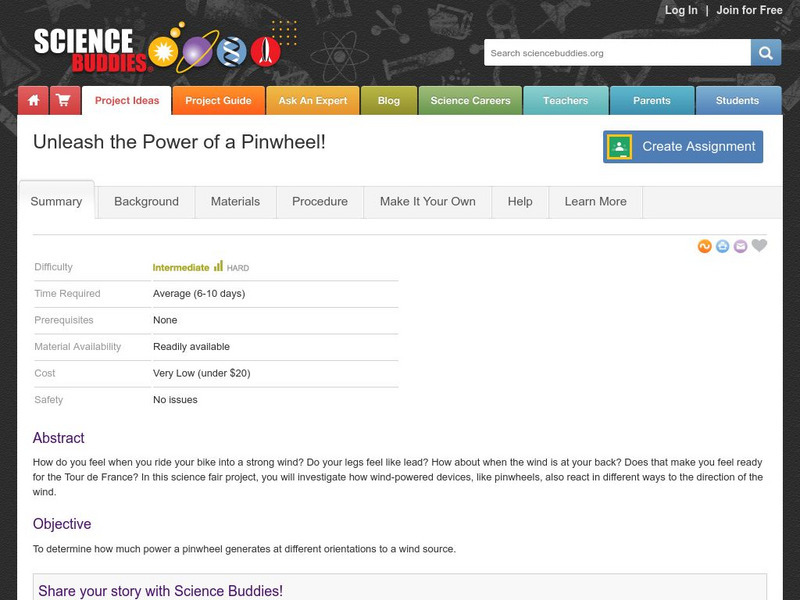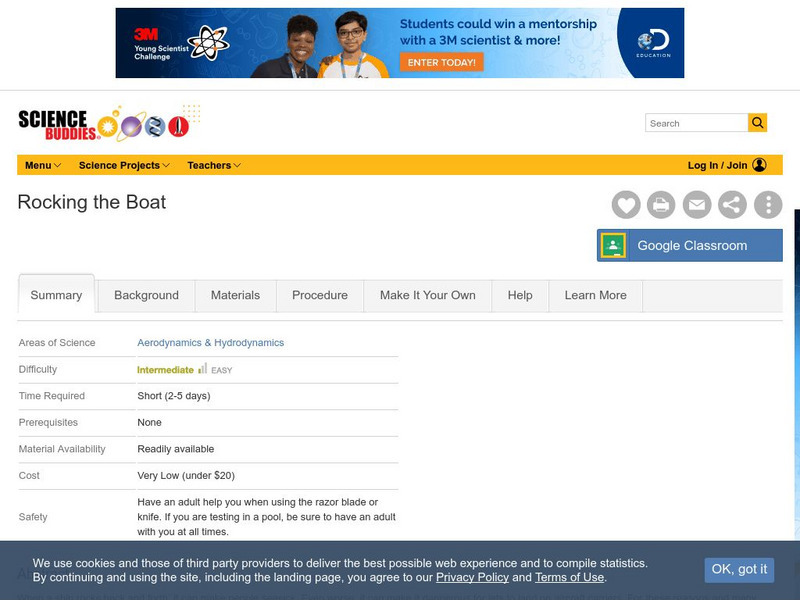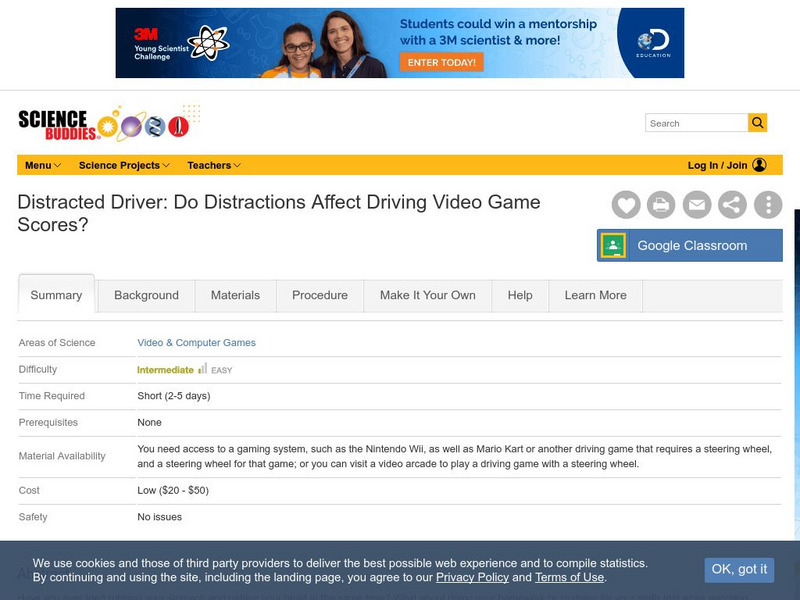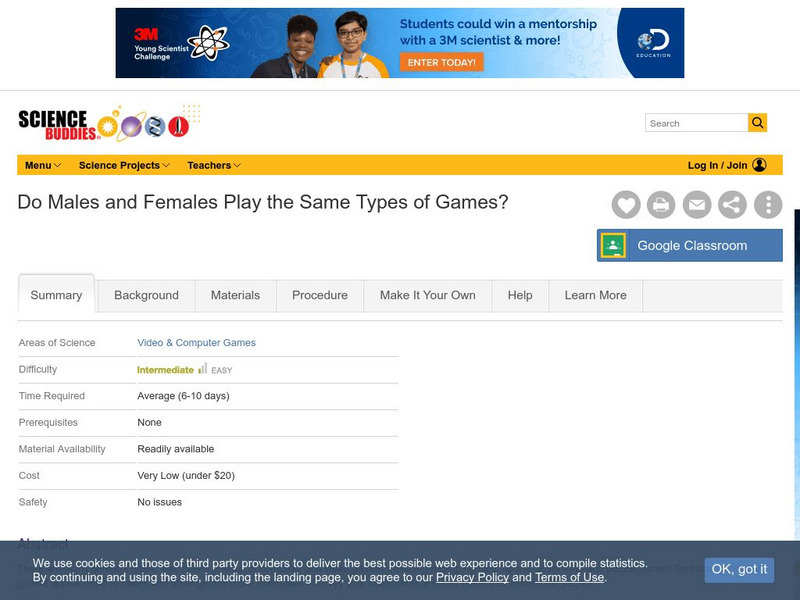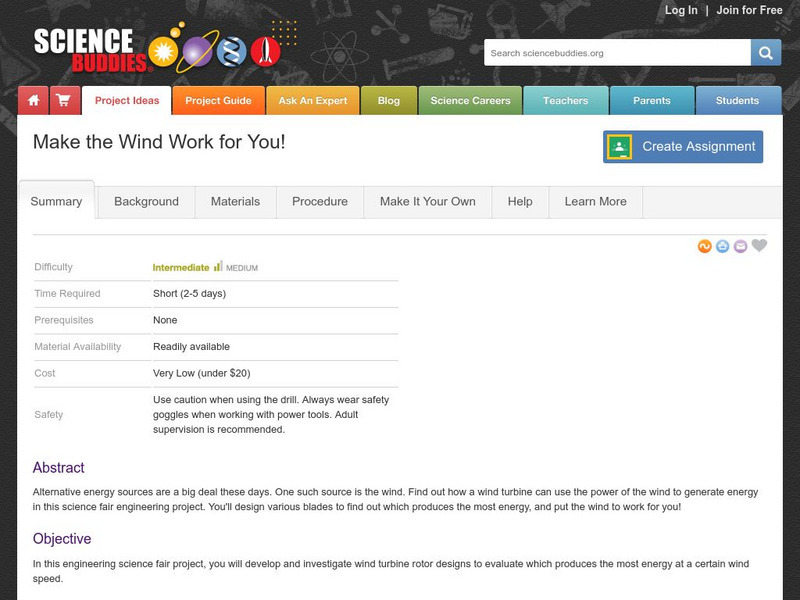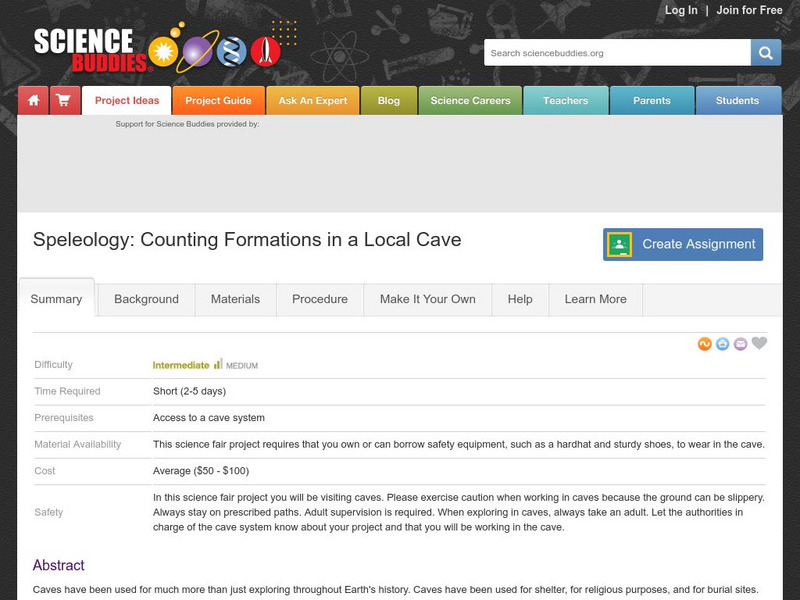Science Buddies
Science Buddies: Green Your Pc: Help Your Computer Save Power
Check out this science fair project to determine how much power your PC really uses, and if it is an energy hog, how you can reduce its appetite for energy. You will learn how to profile and streamline your computer's power usage, while...
Science Buddies
Science Buddies: Do You Have the Willpower to Taste Something Sour?
Do try this mouth-puckering science fair project to find out if people of all ages love sour tastes, or if there a difference between the sour preferences of kids and adults. You might be able to sell creations of your own based on your...
Science Buddies
Science Buddies: Is There Such a Thing as Too Much Gaming?
In this science fair project you will examine real data from a California research scientist of over 3,000 video game players. The objective is to see if there is such thing as a videogame addict.
Science Buddies
Science Buddies: Unleash the Power of a Pinwheel!
In this science fair project, you will learn more about wind-powered devices, like pinwheels. Much like pinwheels, we react in different ways to the direction of the wind when we ride bikes, or even try to walk.
Science Buddies
Science Buddies: Rocking the Boat
Become an engineer for a day and discover the best way to keep from rocking the boat in this engineering science fair project. When a ship rocks back and forth, it can make people seasick, but also it makes it dangerous for jets to land...
Science Buddies
Science Buddies: Do Distractions Affect Driving Video Game Scores?
In this science fair project, you will investigate how distractions affect your focus on a task, such as driving, by looking at how gaming scores are affected as you're talking on a cell phone or having a conversation with a friend. For...
Science Buddies
Science Buddies: Do Males and Females Play the Same Types of Games?
There are many different types, or genres, of computer and video games. This includes racing, fighting, sports, adventure, and puzzle games. Survey your classmates in this science fair project to find out if certain genres of games...
Science Buddies
Science Buddies: Tough Beans: Which Cooking Liquids Slow Softening the Most?
Beans are important to the diets of many people, that is why you always find it cooked a specific way or in a specific dish in different cultures. Here you will learn how the liquid that beans are cooked in affects how quickly or slowly...
Science Buddies
Science Buddies: A Change in the Winds: Studying Bernoulli's Principle
You can actually make objects come together by blowing air between them. This is a simple way of implementing Bernoulli's principle. Find out how wind changes air pressure to bring to objects together in this easy and fun science fair...
Science Buddies
Science Buddies: Make the Wind Work for You!
Find out how a wind turbine can use the power of the wind to generate energy in this science fair engineering project. You will get to design various blades to find out which produces the most energy, and at what wind speeds they are...
Science Buddies
Science Buddies: Gamers: Myth or Man?
Lots of people have preconceived ideas and perceptions of people because of stereotypes. This science fair project will help you examine whether the stereotypes of "gamers" actually matches those that actually play video games.
Science Buddies
Science Buddies: Out of Control!
Some games have control schemes that are real-world based, such as the Nintendo Wii. Your job will be to discover if inexperienced players perform better when using real-world-based control schemes rather than abstract control schemes.
Science Buddies
Science Buddies: What Is the Woolly Mammoth's Closest Living Relative?
Although Woolly Mammoths have been extinct for thousands of years, scientists continue to learn more and more about this mighty animal. Some of the most exciting new research is being produced by looking at DNA extracted from the hair...
Science Buddies
Science Buddies: Use Dna Sequencing to Trace the Blue Whale's Evolutionary Tree
Around 50 million years ago, the mammalian ancestor of today's whales returned to the ocean. In this genomics science fair project, you will use mitochondrial protein sequencing to trace the evolution of whales and identify their closest...
Science Buddies
Science Buddies: Can Your Body Temperature Tell the Time of Day?
If you have ever had to adjust to a new time zone, you have noticed that it takes a while before you start to feel normal again. By shifting your sleep and activity schedule, you have altered the pattern of your body's circadian rhythms....
Science Buddies
Science Buddies: Minding Your Mummies: The Science of Mummification
Mummies have always played a part in nightmares for Western cultures, but in ancient Egypt, mummification was a serious religious ritual. They believed that preserving human remains was necessary so that the previous owner could enjoy...
Science Buddies
Science Buddies: Are Your Eyes Playing Tricks on You?
Yogi Berra said "You can observe a lot by just watching." In this human biology science fair project, you will observe how your eyes perceive color by watching afterimages. Afterimages are what you see after staring at an object for...
Science Buddies
Science Buddies: I See a Full Moon Rising, and Shrinking, or Do I?
The moon appears bigger at the horizon just as it is rising over the treetops, than it does later in the evening when it is overhead. This is because our perception of its size changes based on where it is in the sky. In this human...
Science Buddies
Science Buddies: Blast Into the Past Identify T. Rex's Closest Living Relative
Believe it or not, scientists were recently able to recover tissue and partial sequence information for protein molecules from a 68-million-year-old Tyrannosaurus rex fossil. In this genomics science fair project, you will use the T....
Science Buddies
Science Buddies: Bat Detector: Listen to the Secret Sounds of Bats
Sometimes bats can "whoosh" right by you, and not be seen. In this science fair project, you will be able to detect flying bats by listening in on the ultrasonic signals they produce to locate objects in their environment. The bat...
Science Buddies
Science Buddies: Speleology: Counting Formations in a Local Cave
In the past caves have been used for shelter, for religious purposes, and for burial sites. They were even used for food storage before refrigeration, because they are cool and have constant high humidity. Get ready for an adventure as...
Science Buddies
Science Buddies: With a Little Bread as Bait, Can You Make a Bird Migrate?
You might like to play in the autumn leaves and winter snow, but have you noticed that many birds don't like to stick around for the cold weather? And instead of the birds you're used to seeing in the warm months, your new feathered...
Science Buddies
Science Buddies: The Science of Making Cheese!
Oooey gooey cheese - yum. Who doesn't like a slice of warm pizza straight from the oven? There's nothing quite like a slice of pizza and a glass of milk, so what makes pizza so great? The cheese. But did you know that making cheese is...
Science Buddies
Science Buddies: Tricks for Treats: How Long Does It Take to Train Your Pet?
Have you ever been to an animal show and seen a sea lion balance a ball on his nose, or a tiger jump through a hoop? Or maybe you've met dogs who can sit, fetch, shake, or beg on command. The range of tricks that you can teach animals is...





